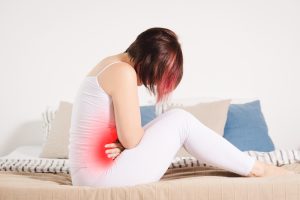
A limiting factor to staying active and maintaining a healthy weight is pain.
When you first start an exercise regime, you will encounter sore achy muscles that can make exercise feel difficult. Starting slow and building up is a great way to ensure that you don’t end up with too much discomfort that will stop you from achieving your goals. Muscle pain associated with a new exercise program is very normal and should not be a deterrent. After a few days of rest you should be able to resume activity and stay on track.
Pain that is not healthy, or is considered abnormal, is: shooting, sharp, stabbing, radiating, chronic, associated with swelling and stiffness… These types of pain sensations can be associated with injury, infection and joint degeneration and they can definitely limit your ability to exercise, stay in shape, and maintain a healthy weight.
Carrying extra weight increases pressure on joints, particularly knees, hips and low back, and this sets up a damaging cycle of joint degeneration, muscular spasm, pain and inactivity. Excess adiposity, or body fat, also releases chemicals that make you feel more pain. Many people in this situation want to get out of it, but with out the ability to exercise, they find weight loss very challenging.
There have been so many advances in effective treatments, that most people don’t have to live in pain and the cycle can be stopped and a happy healthy life restored.
Here is a short list of how to break the pain cycle:
1. Don’t chase pain, stop the inflammation before it starts. This may mean taking an ibuprofen, proteolytic enzymes and anti-inflammatory herbs or Arnica, before exercise to limit inflammation during and post activity.
2. Limit intake of inflammatory foods in order to reduce pain. Foods high in arachidonic acid, mostly from animal fats, increase pain and inflammation. Foods that you are allergic to will also increase inflammation so consider an IgG Food allergy test.
3. Decrease sugar intake. Sugar promotes ageing, inflammation and is dehydrating. Keep sugar low to avoid increased cholesterol levels, diabetes, arthritis, and neurological disorders.
4. Eat Nourishing Foods that are rich in protein, minerals, antioxidants and omega 3 fatty acids.
5. Take supplements that will reduce inflammation and nourish your joints such as curcumin, boswellia and MSM.
6. Get wellness treatments like acupuncture and massage therapy to promote healing, alignment and muscle flexibility.
7. Get Prolotherapy, PRP and/or Neural therapy to repair strains, sprains, and arthritis. Prolotherapy and PRP are administered via injection to increase growth factors (responsible for healing) in the affected area. These treatments have been so effective that, in some cases, surgery has been avoided. With almost a decade experience with PRP and prolotherapy, I have seen so many people recover from their pain.




